Hydrogeological Investigation of a Goaf and Subsidence Area Based on a Ground-to-Air Transient Electromagnetic Sounding Method
Abstract
:1. Introduction
2. Ground-to-Air Transient Electromagnetic Detection Principle
2.1. Instruments and Equipment
2.2. Detection Principle
- Data preprocessing: including data interception, evaluation, and superposition; noise treatment and baseline correction; and time domain signal data pumping.
- Obtaining the ground electrical parameters: based on the obtained comprehensive superposition signal, convert it into a time-varying apparent resistivity curve.
- Apparent resistivity-depth imaging involves filtering the apparent resistivity curve, suppressing interference, and applying other processing techniques to obtain reliable apparent resistivity-depth data. By analyzing the relative changes in electrical properties within the measurement area based on known logging and seismic data, a preliminary understanding of the geological structure of the section is achieved, resulting in the generation of resistivity-depth profiles and slice maps.
2.3. Calculation Principles
3. Overview of the Study Area and Detection Results
3.1. Overview of the Study Area
3.1.1. Geological Conditions of the Study Area
3.1.2. Hydrogeological Conditions of the Study Area
3.1.3. Survey Overview of the Study Area
3.2. Working Methods and Parameters
3.2.1. Testing Task
3.2.2. Operating Parameters
3.2.3. Engineering Layout
3.3. Interpretation of Typical Profiles of Detection Achievements
- (1)
- The Analysis of Profile Results for Test Line 1
- (2)
- The Analysis of Profile Results for Test Line 5
- (3)
- The Analysis of Profile Results for Test Line 6
- (4)
- The Analysis of Profile Results for Test Line 10
- (5)
- The Analysis of Profile Results for Test Line 12
3.4. Result Analysis
3.5. Detection Result Verification
4. Advantages of the Ground-to-Air Transient Electromagnetic Method
5. Conclusions
- Through comparative analysis, the subsidence area, as a whole, exhibits a characteristic low resistance, with resistivity ranging between 5 and 15 Ω·m. The resistivity of the roadway displays significant variations, presenting a beaded resistivity anomaly. The water-filled roadway demonstrates a beaded low-resistivity anomaly, while the non-water-filled roadway exhibits a beaded high-resistivity anomaly.
- The subsidence area, measuring approximately 140 × 120 m, is situated between survey line 1 and line 8 in a funnel-shaped manner. Due to the absence of survey line control on the northern side of survey line 1, the subsidence area remains open-ended, necessitating further exploration work.
- The subsidence area is centered approximately −100 m to −60 m from line 3 to line 4 of the survey, with the main point of water permeation located at the bottom of the funnel.
- The roadway in the middle section of mining area 310 exhibits a low impedance response from line 1 to line 12, which is influenced by subsidence and experiences varying degrees of water infiltration.
- The middle section of 250 has evident low resistance reactions only at lines 5, 9, and 10 of the survey profiles, with partial water filling observed in the roadway. No significant low resistance is detected in other survey line profiles, indicating that most of the roadway in the middle section of 250 and below remains unaffected by collapse and is free from water accumulation.
Author Contributions
Funding
Data Availability Statement
Conflicts of Interest
References
- Yi, D.; Jingrui, L. Research on Multi-parameter Interpretation Method of Advanced Exploration of Mine Transient Electromagnetic Method. In Journal of Physics: Conference Series; IOP Publishing: Bristol, UK, 2023; Volume 2660. [Google Scholar]
- Zhu, Z.; Shan, Z.; Pang, Y.; Wang, W.; Chen, M.; Li, G.; Sun, H.; Revil, A. The transient electromagnetic (TEM) method reveals the role of tectonic faults in seawater intrusion at Zhoushan islands (Hangzhou Bay, China). Eng. Geol. 2024, 330, 107425. [Google Scholar] [CrossRef]
- Jubaedah, N.E.; Parnadi, W.W. On the application of Transient Electromagnetics (TEM) and DC-resistivity methods for groundwater level detection in the Cipatat karst area. In IOP Conference Series: Earth and Environmental Science; IOP Publishing: Bristol, UK, 2023; Volume 1288. [Google Scholar]
- Chao, Q.F.; Gao, W.; Jian, Z.L. An Electromagnetic Scattering Reanalysis Method for Partial Geometry Modifications. IET Microw. Antennas 2023, 17, 701–709. [Google Scholar]
- Ouyang, L.S. Progress in Ground Transient Electromagnetic Methods(TEM). Earthq. Res. Sichuan 2011, 4, 40–45. [Google Scholar]
- Yang, G.; Chen, Y.J.; Jiang, Z.H. The Application of Small Loop TEM to Detecting Water in Goaf. Chin. J. Eng. Geophys. 2011, 8, 309–402. [Google Scholar]
- Yang, Y.J.; He, Z.X.; Zhao, X.M. Research on The Defining All Time Apparent Resistivity of The TEM Method Excitated With Grounding Long Line Current Source. Equip. Geophys. Prospect. 2010, 20, 117–120. [Google Scholar]
- Holladay, J.S.; Doll, W.E.; Beard, L.P.; Lee, J.L.; Gamey, T.J.; Bell, D.T. UXO Time Constant Estimation Form Helicopter Borne TEM Data. J. Environ. Eng. Geophys. 2006, 11, 43–52. [Google Scholar] [CrossRef]
- Guo, L.W. Study on The Method of Grounded-Wire TEM for WholeFied Exploration. Master’s Thesis, Chengdu University of Technology, Chengdu, China, 2013. [Google Scholar]
- Dai, Q.W.; Hou, Z.C.; Chai, X.C. Application of Transient Electromagnetic Method And EH-4 to Investigation of Mined-out Areas of Molybdenum Deposits. Prog. Geophys. 2013, 28, 1541–1546. (In Chinese) [Google Scholar]
- Wang, P.; Zhang, W.; Li, J.; Deng, Z.; Wang, Y. Discussion on the Application of Integrated Aerogeophysical Method in Urban Site Selection and Construction. In Journal of Physics: Conference Series; IOP Publishing: Bristol, UK, 2023; Volume 2651. [Google Scholar]
- Lei, D.; Hu, X.Y.; Zhang, S.F. Development Status Quo of Airborne Electromagnetic. Contrib. Geol. Miner. Resour. Res. 2006, 21, 40–53. [Google Scholar]
- Fuxue, Y.; Yishu, S.; Yang, Z.; Jun, L. Design of High Transmission Frequency Circuit for Multiturn Small Loop Transient Electromagnetic Detection. In Journal of Physics: Conference Series; IOP Publishing: Bristol, UK, 2023; Volume 2651. [Google Scholar]
- Zhang, C.D. Airborne Time Domain Electromagnetics system:Look Back and Ahead. Chin. J. Eng. Geophys. 2006, 3, 265–273. [Google Scholar]
- Chen, J.J.; Liu, B.; Wang, P.L.; Yin, K.; Li, Y.; He, P. Application research of integrated geophysical exploration techniques to gypsum mine gob. Prog. Geophys. 2018, 33, 783–796. (In Chinese) [Google Scholar]
- Feng, B.; Meng, X.H.; Zhang, B. Transmitting coil boundary effect for TEM large loop source and Elimination method. Coal Geol. Explor. 2010, 38, 61–66. (In Chinese) [Google Scholar]
- Li, J.G.; Li, J.H. Application of transient electromagnetic method in coalmine gob area grouting effect detection. Coal Geol. China 2012, 24, 68–71. (In Chinese) [Google Scholar]
- Yang, J.M.; Wei, Z.Z. The application of the methods of high density resistivity method and transient electromagnetic to detecting coal mining goaf and to inspect grouting effect. Prog. Geophys. 2014, 29, 362–369. (In Chinese) [Google Scholar]
- Yu, J.C.; Li, Z.D. The high density resistivity method used for detecting foundation grouting. Geol. Prospect. 1998, 34, 48–51. [Google Scholar]
- Nabighian, M.N. Electromagnetic Methods in Applied Geophysics-Theory; Society of Exploration: Tulsa, OK, USA, 1988; Volume 1, pp. 217–231. [Google Scholar]
- Elliott, P. New Airborne Electromagnetic Method Provides Fast Deep-target Data Turnaround. Lead. Edge 1996, 15, 309–310. [Google Scholar] [CrossRef]
- Elliott, P. The Principles and Practice of FLAIRTEM. Explor. Geophys. 1998, 29, 58–60. [Google Scholar] [CrossRef]
- Mogi, T.; Tanaka, Y.; Kusunoki, K.I.; Morikawa, T.; Jomori, N. Development of Grounded Electrical Source Airborne Transient EM (GREATEM). Explor. Geophys. 1998, 29, 61–64. [Google Scholar] [CrossRef]
- Li, S.Y.; Lin, J.; Yang, C.H.; Tian, P.P.; Wang, Y.; Yu, S.B.; Ji, Y.J. Ground-Airborne electromagnelic signals de noising using a combined wavelet transiormalgorithm. Chin. J. Geophys. 2013, 56, 3145–3152. [Google Scholar]
- Wang, Y.; Ji, Y.; Li, S.; Lin, J.; Zhou, F.; Yang, G. A Wavelet-based BaseLine Drift Correction Method for Grounded Electrical Source Airborne Transient Electromagnetic Signals. Explor. Geophys. 2013, 44, 229–237. [Google Scholar] [CrossRef]
- Ji, Y.J.; Wang, Y.; Xu, J.; Zhou, F.D.; Li, S.Y.; Zhao, Y.P.; Lin, J. Development and application of the grounded long wire source airborne electromagneliccxploration system based on an unmanned airship. Chin. J. Crophys. 2013, 56, 3640–3650. (In Chinese) [Google Scholar]
- Cun, Z.; Qingsheng, B.; Penghua, H. A review of water rock interaction in underground coal mining: Problems and analysis. Bull. Eng. Geol. Environ. 2023, 82, 157. [Google Scholar]
- Zhang, C.; Tu, S.; Zhao, Y. Compaction characteristics of the caving zone in a longwall goaf: A review. Environ. Earth Sci. 2019, 78, 27. [Google Scholar] [CrossRef]
- Zhang, C.; Chen, Y.; Ren, Z.; Wang, F. Compaction and seepage characteristics of broken coal and rock masses in coal mining: A review in laboratory tests. Rock Mech. Bull. 2024, 3, 100102. [Google Scholar] [CrossRef]
- Huang, D.R.; Lan, T.; Wu, Z.Y. Geological characteristics of Luotang gypsum deposit in Jiangxi province. Resour. Surv. Environ. 2011, 32, 137–142. (In Chinese) [Google Scholar]
- Kong, F.N. Hankel transform filters for dipole antenna radiation in a conductive medium. Geophys. Prospect. 2010, 55, 83–89. [Google Scholar] [CrossRef]
- Yang, S.P.; Jiao, B.Q.; Sun, Z.J.; Zhang, X.J.; Xu, R.T.; Lu, X.P.; Pan, W.S.; Pu, X.Z. The Follow-up Methods for Regional Geochemical Anomalies in Forest-swamp Landscape Areas. Geophys. Geochem. Explor. 2008, 32, 480–487. [Google Scholar]
- Han, G.; Liu, M.; Li, X.; Zhang, Q. Sources and geochemical behaviors of rare earth elements in suspended particulate matter in a wet-dry tropical river. Environ. Res. 2023, 218, 115044. [Google Scholar] [CrossRef]
- Ye, Y.X.; Deng, J.Z.; Li, M.; Yang, H.Y. Application status and vistas of electromagnetic methods to deep ore prospecting. Prog. Geophys. 2011, 26, 327–334. (In Chinese) [Google Scholar]
- Kaufman, A.A.; Keller, G.V. Frequency and Transient Soundings; Elsevier Applied Science Publishers, Ltd.: London, UK, 2014. [Google Scholar]
- Weir, G.J. Transient electromagnetic fields about an infinitesimally long grounded horizontal electric dipole on the surface of a uniform half-space. Geophysics 1980, 61, 41–56. [Google Scholar] [CrossRef]
- Liao, X.; Xu, Z.; Liu, W.; Tai, H.M.; Zhou, J.; Ma, X.; Fu, Z. Electromagnetic Detection System with Magnetic Dipole Source for Near-Surface Detection. Sensors 2023, 23, 9771. [Google Scholar] [CrossRef]
- Xue, G.Q.; Chen, W.Y.; Zhou, N.N.; Li, H. Short-off set TEM technique with a grounded wire source for deep sounding. Chin. J. Geophys. 2013, 56, 255–261. (In Chinese) [Google Scholar]
- Xue, G.Q.; Pan, D.M.; Yu, J.C. Review the applications of geophysical methods for mapping coal-mine voids. Prog. Geophys. 2018, 33, 2187–2192. (In Chinese) [Google Scholar]
- Hong, Z.Z.; Guang, H.W.; Xiao, D.P. Evaluation Method of Noise Electromagnetic Radiation Interference Effect. IEEE Trans. Electromagn. Compat. 2023, 65, 69–78. [Google Scholar]
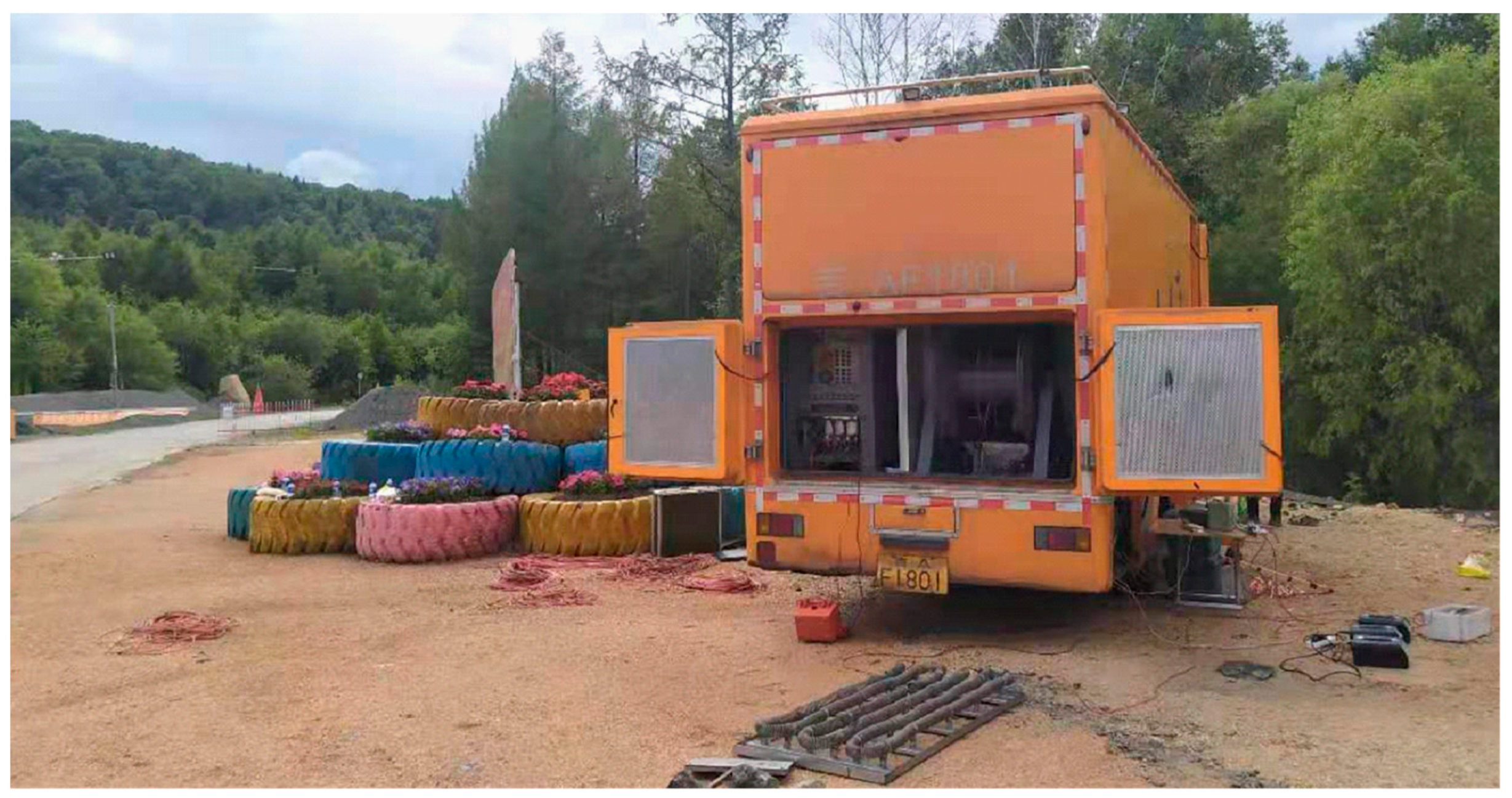

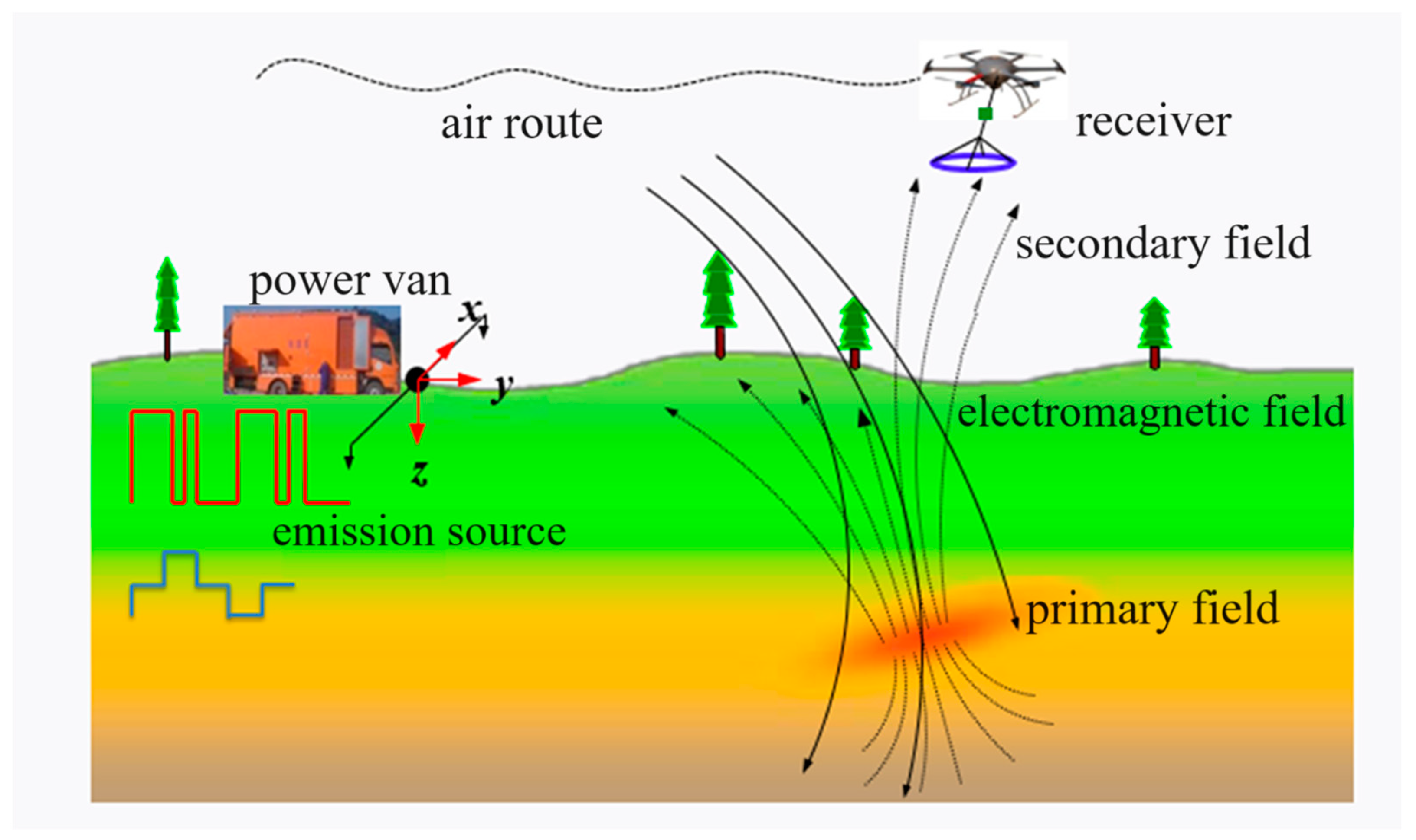

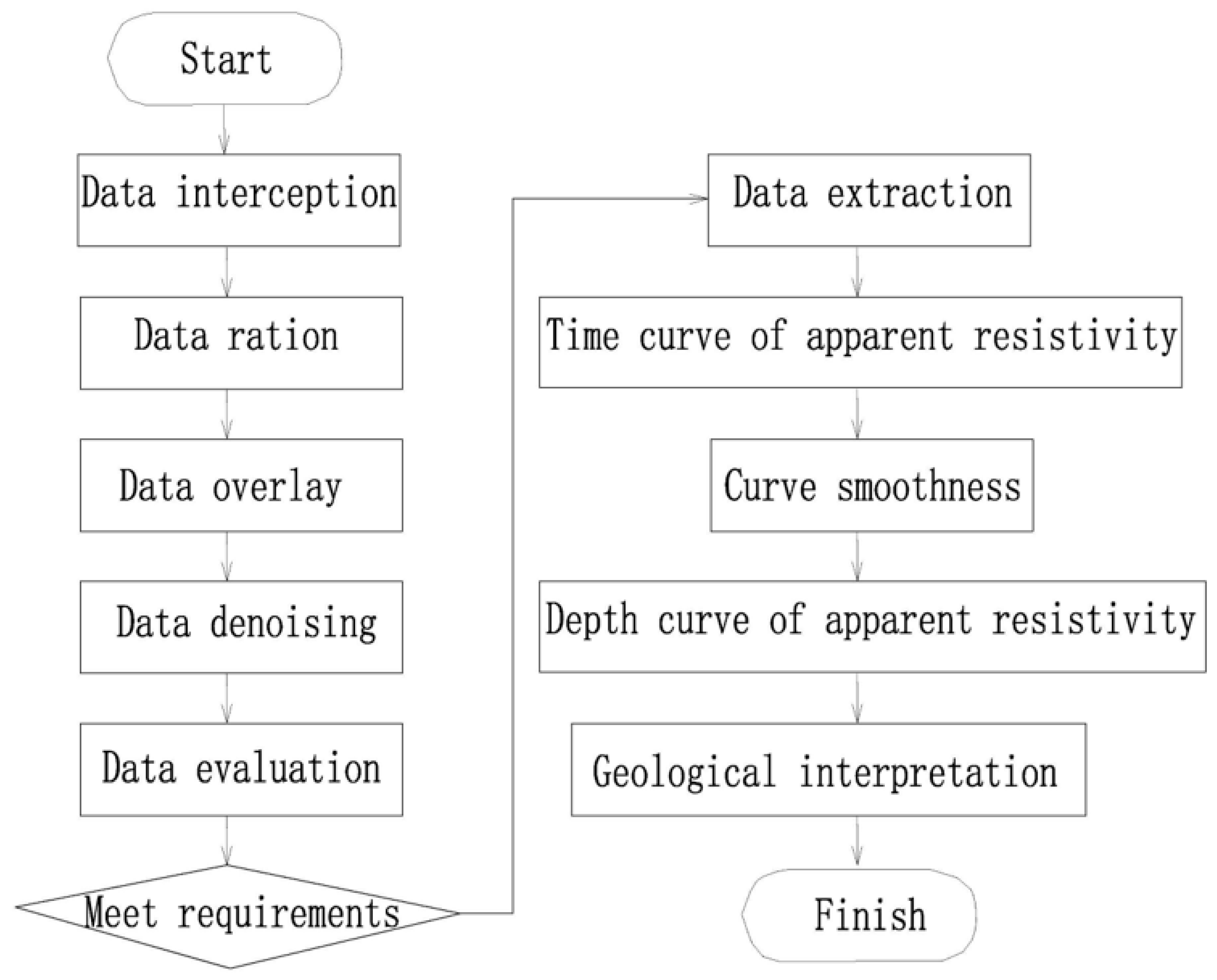
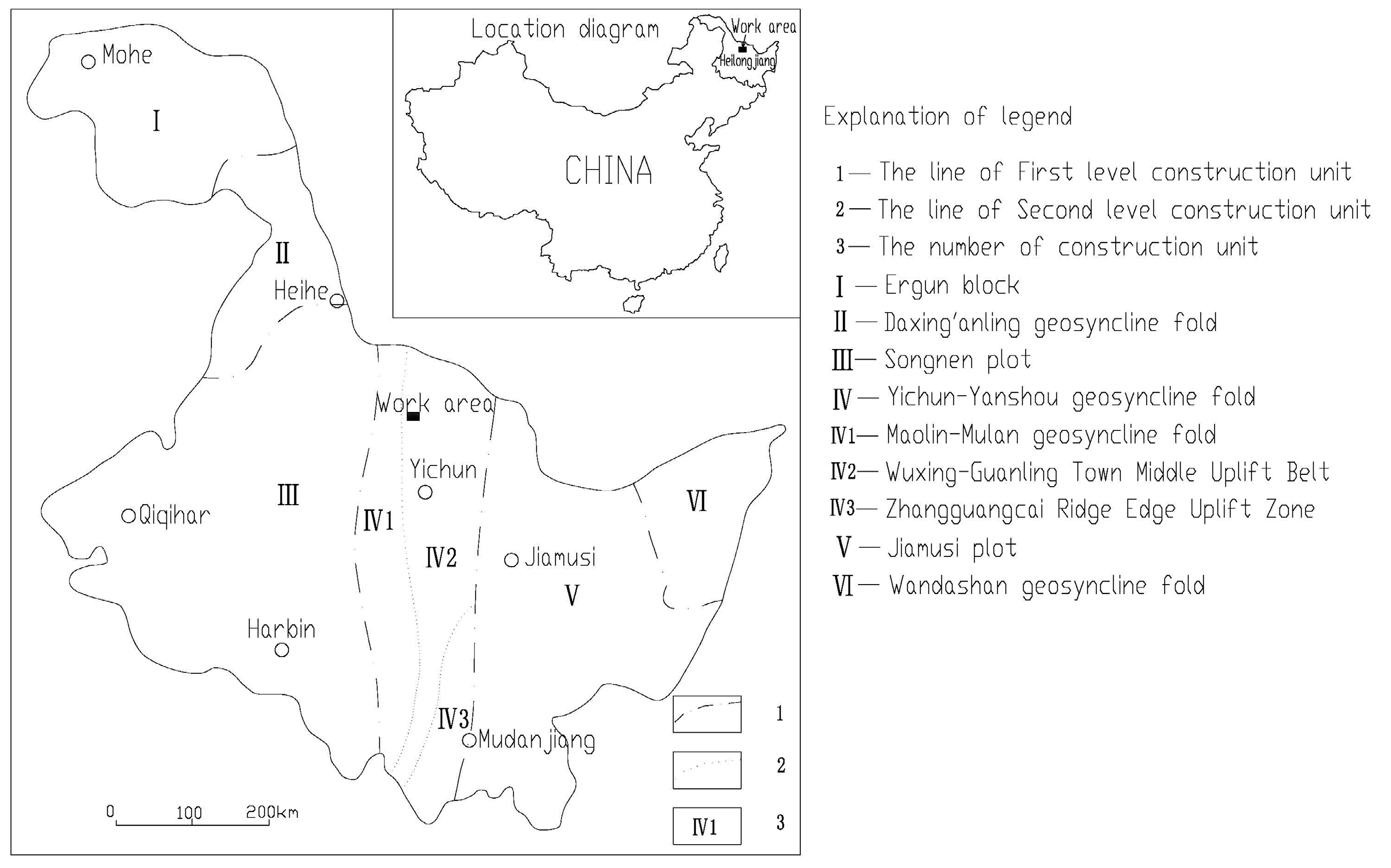

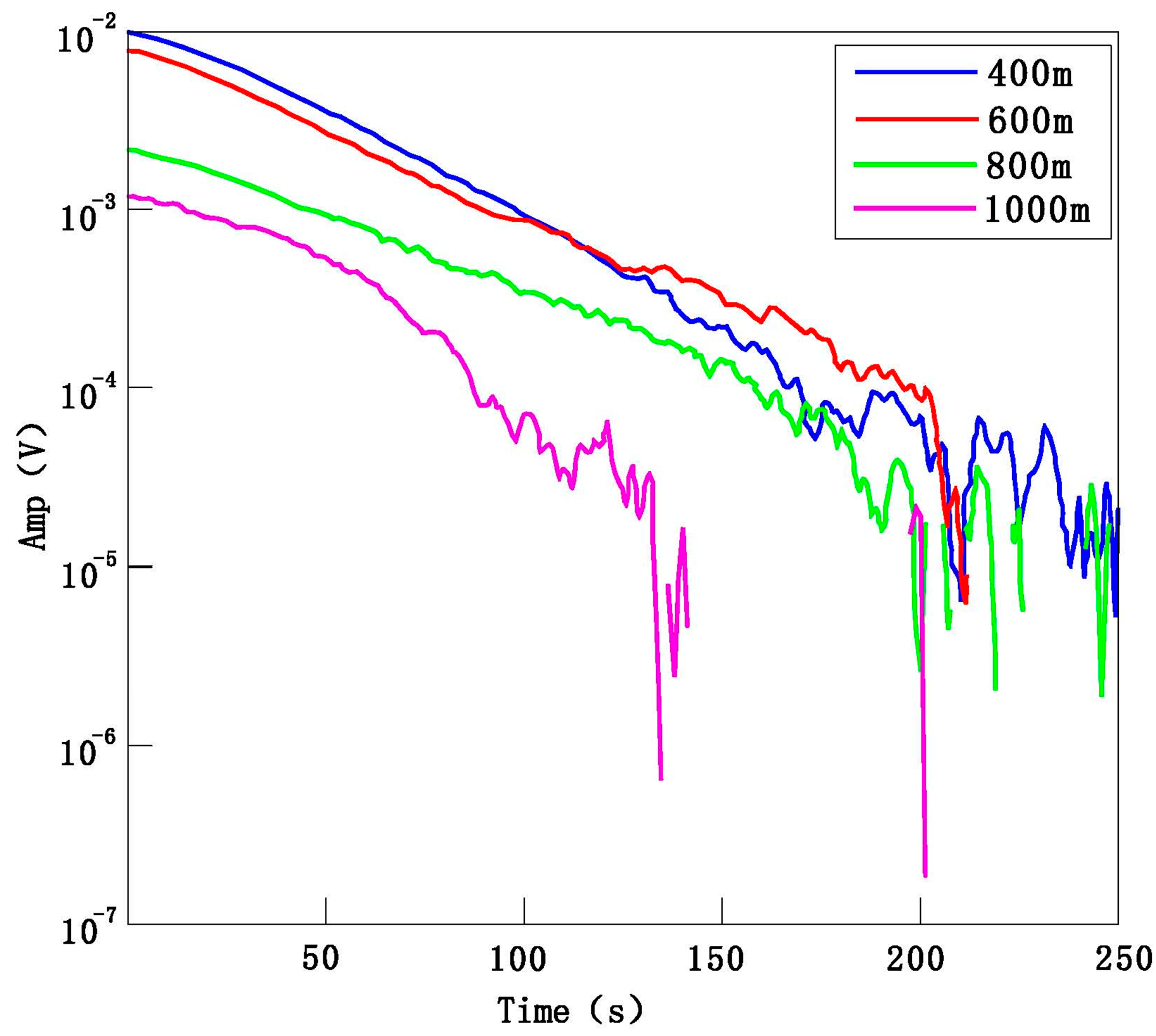





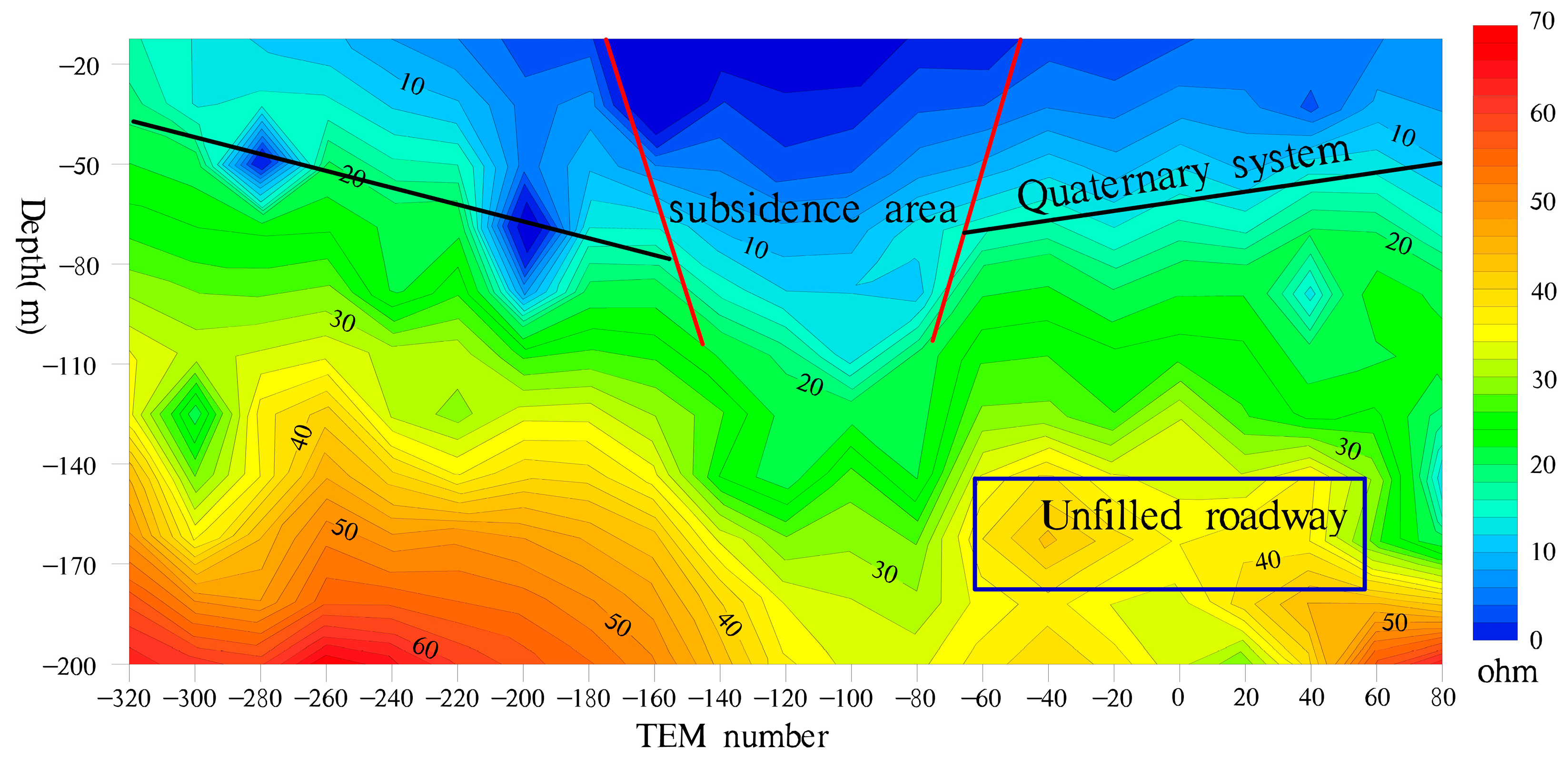
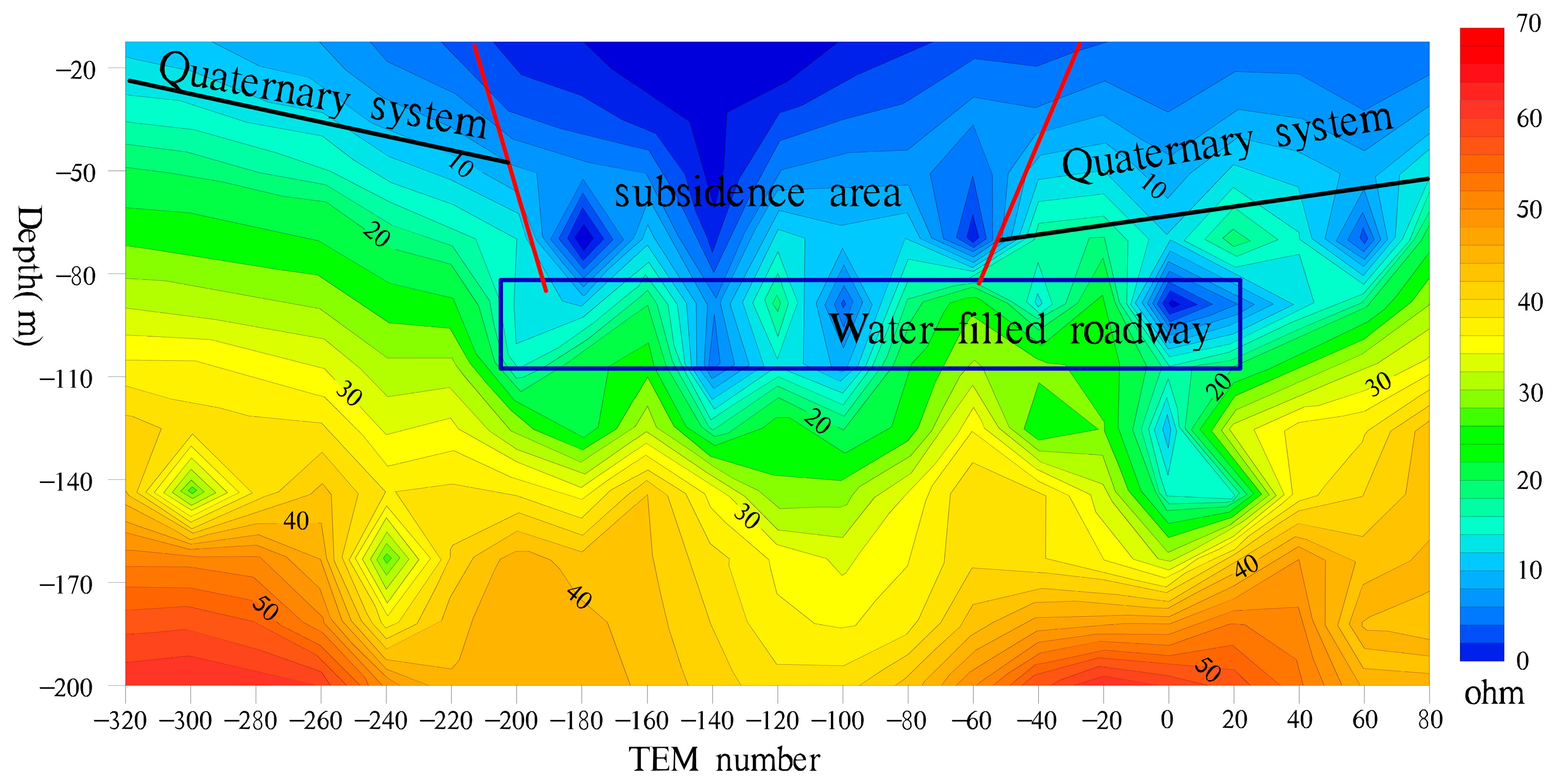
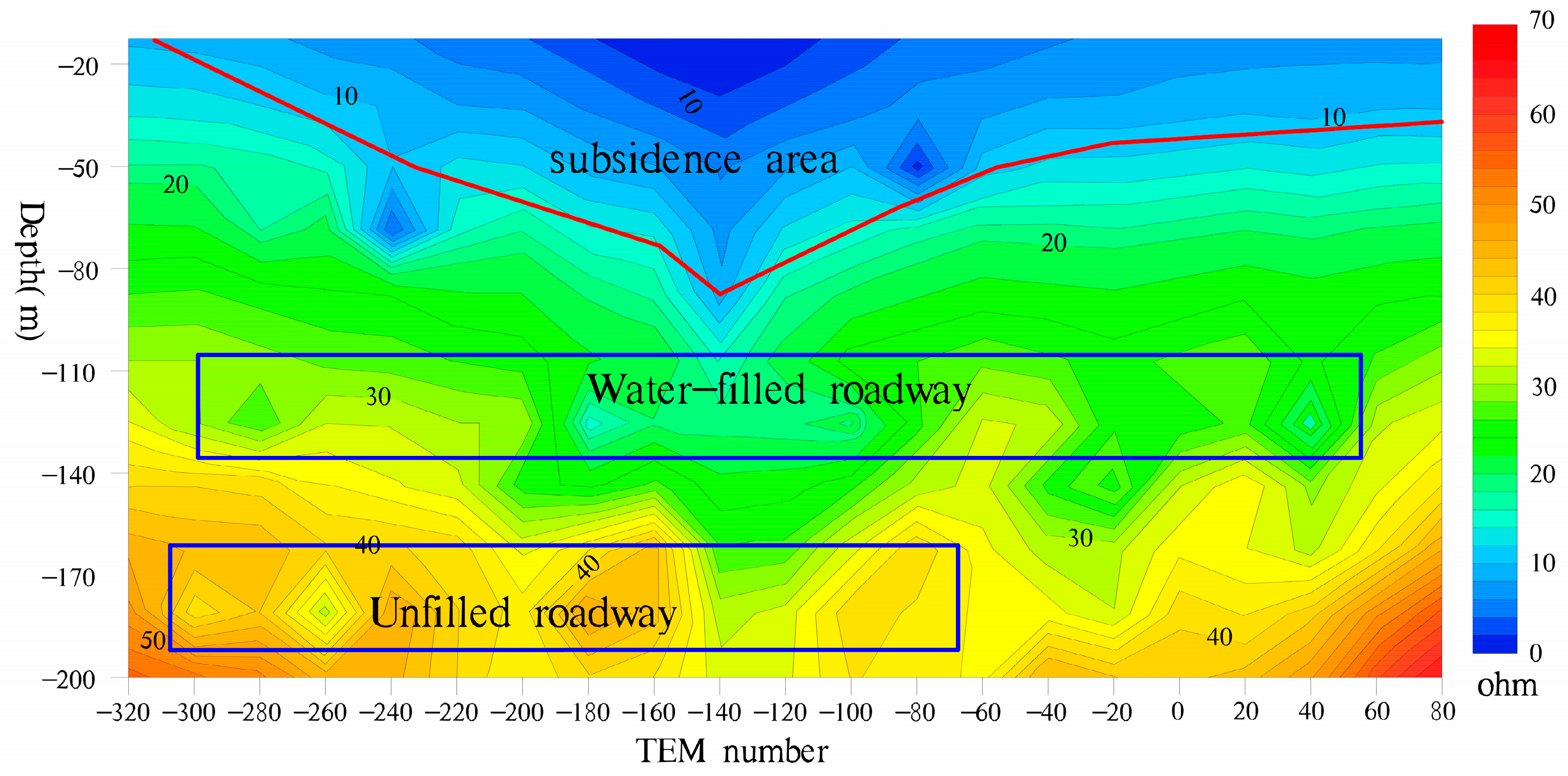


| Groundwater Type | Aquifer Lithology | Abundant in Water | Trait |
|---|---|---|---|
| Quaternary alluvial sand gravel pore water | Mainly sand, gravel sand, gravel | Strong rich water, the water inflow of a single well is generally 3000~5000 m3/d. | The aquifer is 400–460 m wide and 35 m thick. The maximum water inflow of a single well is 6907.68 m3/d. Strong rich water. The hydrochemical type is heavy carbonate-calcium type. |
| Network weathering crevice water | Crystalline limestone, crystalline dolomite, dolomitic crystalline limestone, granite, skarn, metamorphic sandstone | Weak rich water, single well water inflow is generally 30~300 m3/d | The thickness of the aquifer is 37.05–73.74 m and the water output from a single hole is 17.19–65.23 m3/d, with weak water richness. The hydrochemical types are bicabonate-calcium and sodium. |
| Solution fissure water resembling a carbonate dike | Crystalline limestone, crystalline dolomite, dolomitic crystalline limestone, granite, skarn, metamorphic sandstone | The upper part is moderately rich in water, and the water inflow of a single well is generally 800~1500 m3/d. The lower part is weak and rich in water, and the water inflow of a single well is generally 10~300 m3/d | The rich water above 190 m elevation is medium, and the rich water at a deep depth is weak. The hydrochemical types are bicabonate-calcium and sodium. |
| Fractured water in non-carbonate dike structures | Granite, skarn, metamorphic sandstone | Weak rich water, single well water inflow 10~100 m3/d | The thickness of the aquifer is 42.98–70.10 m and the water output from a single hole is 7.09–42.16 m3/d, with weak water richness. The hydrochemical type is heavy carbonate—calcium—sodium type. |
| Falling body cracking crack water | Dolomitic crystalline limestone | It has strong water richness and water permeability | The thickness of the aquifer is 42.98–70.10 m and the water output from a single hole is 7.09–42.16 m3/d, with weak water richness. The hydrochemical type is heavy carbonate—calcium—sodium type. |
Disclaimer/Publisher’s Note: The statements, opinions and data contained in all publications are solely those of the individual author(s) and contributor(s) and not of MDPI and/or the editor(s). MDPI and/or the editor(s) disclaim responsibility for any injury to people or property resulting from any ideas, methods, instructions or products referred to in the content. |
© 2024 by the authors. Licensee MDPI, Basel, Switzerland. This article is an open access article distributed under the terms and conditions of the Creative Commons Attribution (CC BY) license (https://creativecommons.org/licenses/by/4.0/).
Share and Cite
Feng, Q.; Li, C.; Hao, S.; Li, D.; Liu, T.; Sun, Z.; Zhou, L. Hydrogeological Investigation of a Goaf and Subsidence Area Based on a Ground-to-Air Transient Electromagnetic Sounding Method. Water 2024, 16, 1067. https://doi.org/10.3390/w16071067
Feng Q, Li C, Hao S, Li D, Liu T, Sun Z, Zhou L. Hydrogeological Investigation of a Goaf and Subsidence Area Based on a Ground-to-Air Transient Electromagnetic Sounding Method. Water. 2024; 16(7):1067. https://doi.org/10.3390/w16071067
Chicago/Turabian StyleFeng, Qicai, Chang Li, Shuren Hao, Dongsheng Li, Tao Liu, Zhonglin Sun, and Ling Zhou. 2024. "Hydrogeological Investigation of a Goaf and Subsidence Area Based on a Ground-to-Air Transient Electromagnetic Sounding Method" Water 16, no. 7: 1067. https://doi.org/10.3390/w16071067
APA StyleFeng, Q., Li, C., Hao, S., Li, D., Liu, T., Sun, Z., & Zhou, L. (2024). Hydrogeological Investigation of a Goaf and Subsidence Area Based on a Ground-to-Air Transient Electromagnetic Sounding Method. Water, 16(7), 1067. https://doi.org/10.3390/w16071067





